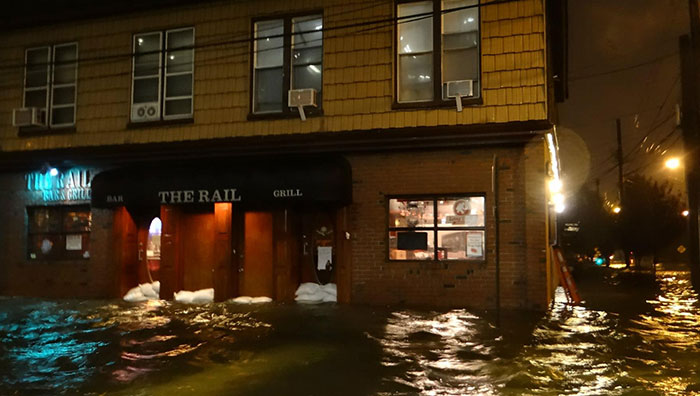Forum Photo by Richard York
The bill would reauthorize the NFIP for 10 years. The program is set to expire on Sept. 30.
By Michael V. Cusenza
A bipartisan team of U.S. senators recently introduced legislation to reauthorize the National Flood Insurance Program. The program is currently set to expire on Sept. 30.
The proposed legislation, according to Sens. Kirsten Gillibrand (D-N.Y.), Bill Cassidy, M.D. (R-LA), and Shelley Moore Capito (R-WV), would reauthorize the NFIP over a 10-year term (2017-2027), which is needed to avoid short-term extensions and program lapses that create uncertainty in both the insurance and housing markets.
“Millions of New Yorkers rely on the National Flood Insurance Program to protect their property when a flood occurs,” Gillibrand said. “After Superstorm Sandy hit New York, this program failed too many families who had paid their premiums and were relying on their insurance to rebuild. We cannot turn our backs and let this happen again. This bipartisan bill would help ensure that flood insurance is more affordable and not riddled with the loopholes that left homeowners on their own fighting with insurance companies while trying to recover from the devastation. It would also provide more money to help communities protect against flood risk, like those currently experiencing record flooding along Lake Ontario and the Saint Lawrence River. I am proud to lead this fight with Senator Cassidy, and I will continue to do everything I can to stand with New York homeowners.”
The legislation also reforms the beleaguered NFIP in part by:
Modernizing Flood Mapping
and Flood Risk Accuracy
• Reauthorizes the National Flood Mapping Program. With nearly 3 million miles of unidentified flood hazard areas; along with the need to update and accurately assess risk of existing flood zones; the National Flood Mapping Program shall be reauthorized at a funding level of $500 million annually.
• Provides Mapping Standards and Guidelines for Nongovernmental Entities. Allows localities to elect to develop their own alternatives to NFIP flood maps. FEMA and the Technical Mapping Advisory Council (TMAC) shall provide map standards for flood maps developed by communities, subject to approval by FEMA, thereby giving communities additional avenues to streamline the FEMA mapping process and develop maps that use updated community data & technology.
• Encourages the Use of High-Resolution Mapping Technology. Instructs FEMA to facilitate, partner, and leverage current high resolution topographic data (e.g., Light Detection and Ranging data, or other new and emerging technologies) in the development of flood insurance rate maps.
• Improves the Flood Mapping of Levee-Protected Areas. FEMA shall replace its “Zone D” designation (defined as an area of undetermined/undefined risk) in levee-protected areas with risk zones that are more appropriate for the level of protection that the flood mitigation features affords. Often, premiums in Zone D are higher than in low/moderate risk zones. Low/moderate risk shall be assigned to the new zone until actuarial rates are promulgated.
Enhancing National
Flood Insurance Program
Transparency and Accountability
• Institutes Deadlines for NFIP Claims Determinations. Requires NFIP administrators to make determinations on flood claims within 30 days of the initial filing, followed by any payment owed under the claim. Prevents claims denial based on Proof of Loss requirements. Establishes notice of a claim deadline within 60 days and moves the proof of loss deadline to 180 days.
• Increases Transparency for Engineering Reports and other Claims Document. Requires FEMA to transmit final engineering reports to the policyholder and prohibits anyone other than the individual responsible for the report to make alterations.
• Increases Statute of Limitations for Disputed Claim Payments. Extends the Statute of Limitations for individuals to seek a judicial remedy for a disputed claim payment or a denial of a claim or appeal to 2 years after the flood event or 90 days after the claim is denied, whichever is later.
• Increases Accountability of NFIP Contractors. Gives FEMA greater authority to oversee contractors and litigation costs arising from NFIP claims in order to protect against fraud and excessive billing by companies. It also ensures that NFIP contractors are not shielded from civil liability when they commit fraud.
In 2015, CBS newsmagazine “60 Minutes” aired a segment detailing how private engineering companies purposefully altered engineering reports so as to not fully reflect the true impact and damage caused by Superstorm Sandy to New Yorkers’ homes, which led to the unjust denial or underpayment of flood insurance claims. Hundreds of flood-damage reports were allegedly falsified, and both engineering firms and insurance companies were placed under investigation by the Department of Homeland Security Office of Inspector General and state Attorney General Eric Schneiderman for possible criminal conduct.
As a result, federal officials announced in March 2015 that FEMA has agreed to reopen and review every flood insurance claim—approximately 144,000—filed by Sandy victims, and not limit corrective action to just the 2,200 that were in litigation at the time.

